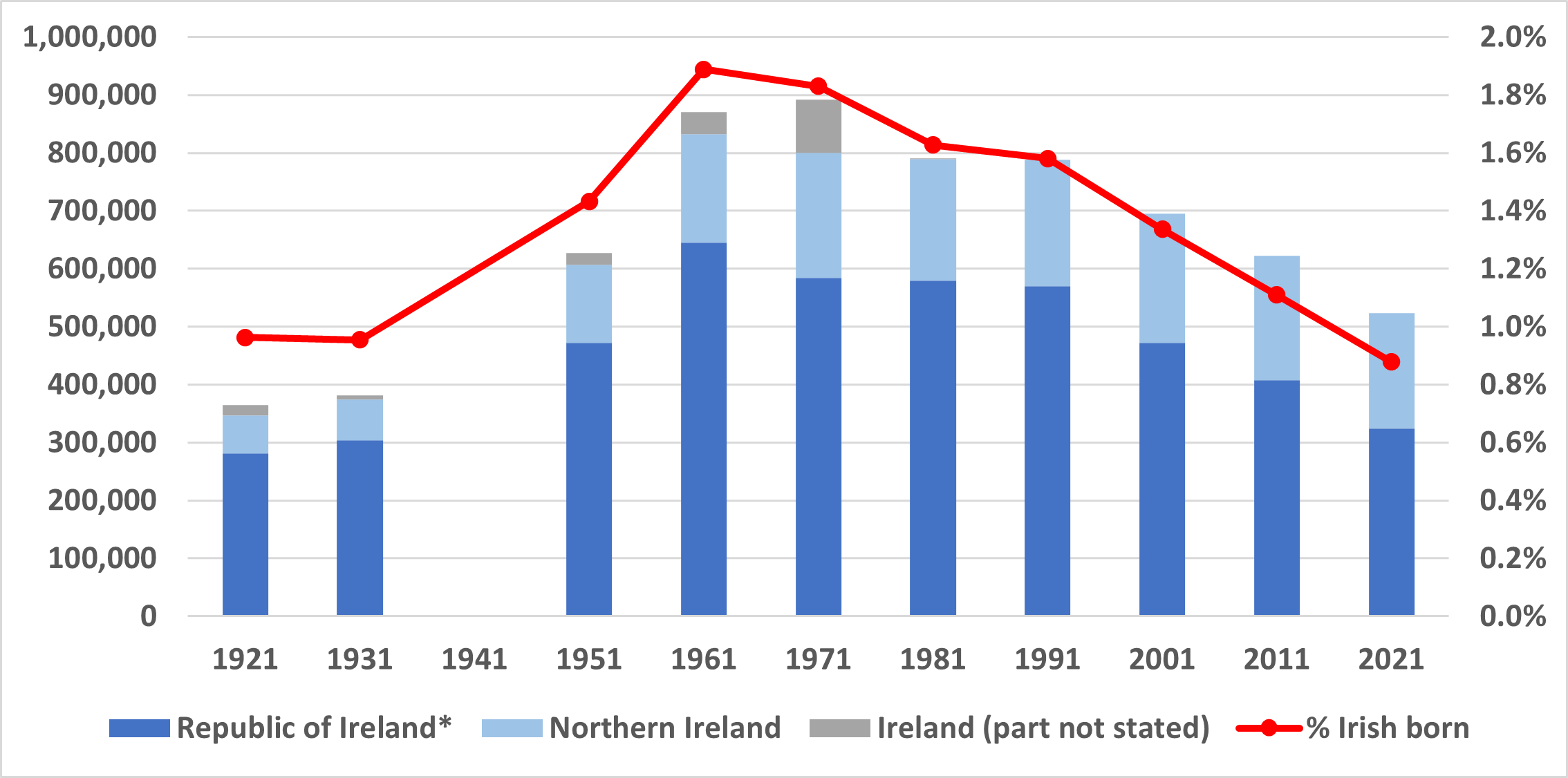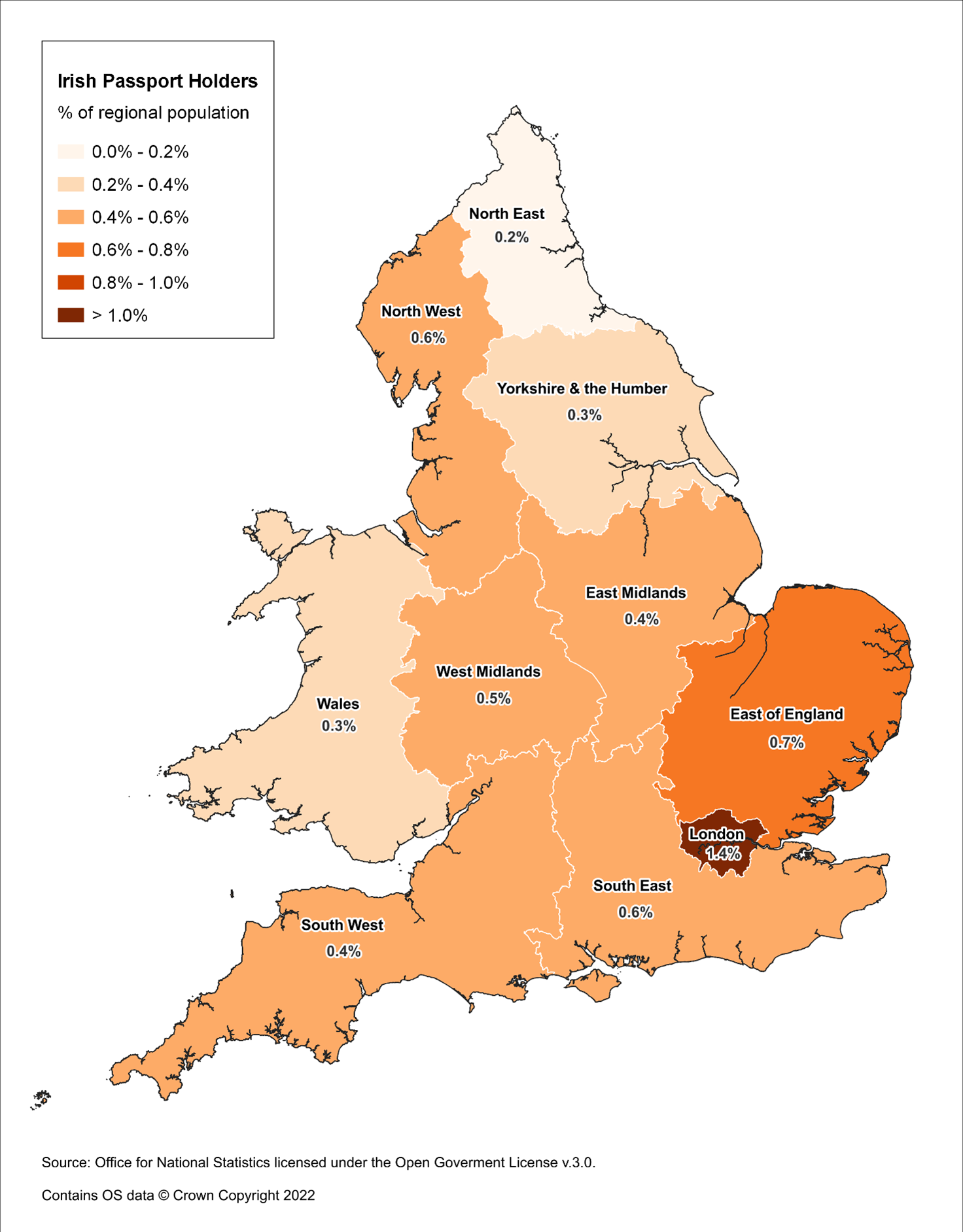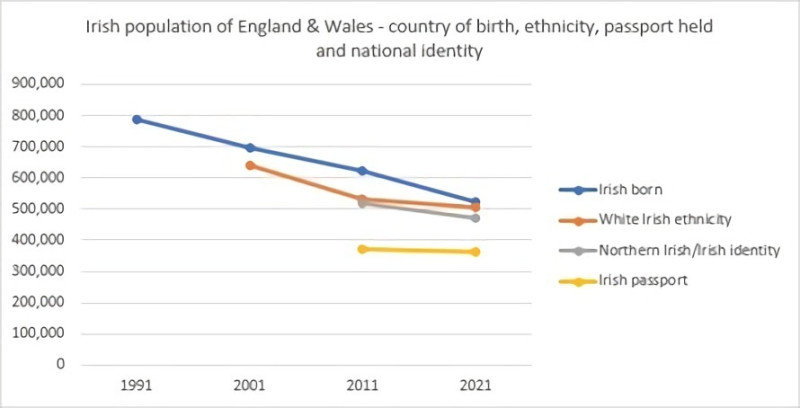What the UK Census really says about the number of Irish in Britain
Analysis: it's important to differentiate between the 'Irish population' as seen in the UK Census and the reality of the broader 'Irish community'
By Alessio D'Angelo, University of Nottingham and Louise Ryan, London Metropolitan University
In 2021, there were about 80,000 fewer Irish-born people living in England and Wales than a decade before. This is one of the findings emerging from the UK Census data recently released by the Office for National Statistics.
The results have led many to talk about a 'dwindling' community, promoting a melancholic narrative of decline. But the story behind the official statistics is much more complex and exciting, as seen in the Census 2021 analysis' project.
It is true that the number of people born in the Republic of Ireland and living in England and Wales in 2021 at 324,670 marks a decrease of over 82,687 (or around 20%) compared to the 2011 Census. Likewise, the number of those born in Northern Ireland went from 214,988 to 198,344. This significant change has occurred against an overall increase of the non-UK born population, which has risen from 7.5 million in 2011 to 10 million in 2021 (+33%).
 England and Wales population by country of birth per UK Census 1921 to 2021
England and Wales population by country of birth per UK Census 1921 to 2021
There are many factors that have contributed to this, including the age profile of the Irish population in Britain (significantly older than the national average) and a historic change of migration trends, including a considerable element of return migration to Ireland. In fact, we can anticipate a further reduction of their numbers in the coming years as first generations of Irish migrants become older.
It becomes ever so important then to gather as much oral history from them as possible to preserve their heritage. Thankfully, we are seeing many examples of this. Prof Louise Ryan is currently undertaking an oral history project, in partnership with documentary maker Grainne McPolin, about retired Irish nurses and their invaluable contribution to the NHS. For their part, the Irish in Britain national membership body for Irish community organisations in Britain have recently announced a new initiative funded by the National Lottery Heritage Fund to celebrate their 50th anniversary.
But focusing only on data about 'country of birth' can lead to a simplistic reading of the wider picture. When you bring together also the statistics on citizenship, national identity, and ethnicity, new layers are added to the story. Take, for example, the Census data on ‘passport held’. In 2021, there were 364,725 people living in England and Wales and holding a passport issued by the Republic of Ireland. This number represents only a very small reduction (-2.1%) when compared to the 2011 Census (372,389) and is nearly compensating the reduction of those who are Irish ‘by birth’.
 Irish passport holders in England and Wales per UK Census 2021
Irish passport holders in England and Wales per UK Census 2021
A Brexit effect seems to be at play here, where people who previously held a British passport have applied for an Irish one, thanks to family links. Even ahead of the 2016 UK referendum to leave the EU, Ireland's Department for Foreign Affairs had reported unprecedented numbers of applications. A pragmatic choice, maybe, but it has also represented an occasion for many to embrace their Irish heritage in the post-Brexit landscape.
Since the turn of the century, the UK Census has also been collecting data on 'Ethnicity'. In this respect, the number of people in England and Wales who identified as 'White Irish’ in 2021, with a total of 507,465, has fallen by 4.4% over a decade, 23,622 down from the previous Census of 2011. At the same time, it is important to point out that the percentage of those who identify as White Irish remains unchanged relative to the population with 0.9% the same figure recorded a decade ago. Meanwhile, there has been an overall increase of Ethnic Minorities, with those identifying as other than ‘White British’ being over 75% of the total. Interestingly, the number of those self-identifying as ‘Gypsy or Irish Traveller’ has grown from 57,700 to 67,800.
We should bear in mind that these Ethnicity figures capture only a fraction of the second and third generations of Irish heritage. The very fact that the Census categories conflate Irishness with Whiteness is increasingly problematic. Between 2011 and 2021, there has been a notable increase in ‘Mixed or multiple ethnic groups’ in England and Wales: from 1.2 to 1.7 million people (2.9% of all residents).

As highlighted by the ONS’ own reports, Ethnicity also varies within households and across generations. In 2021, 10% of households had more than one ethnic group represented; and in 1.8 percent "ethnic groups differ between generations but not within partnerships". Although the Census form allowed ‘write in’ responses, many people of mixed ethnicity would struggle to identify with any of the categories on offer and thus feel excluded. This would apply to many people with an Irish background.
The last few years have seen constant discussions about ways to further improve the Census questionnaire, with some suggestions to get rid of it altogether. Whatever will happen next, the value and interest of the current statistics is twofold: they provide us with a rich and detailed source of evidence and, even with their inherent limitations, they allow us to reflect on the increasing complexity of people’s identities in contemporary Britain.
As visits to Irish cultural and community centres, across Britain will show, the community is thriving
Over the coming months, the ONS will published more detailed datasets and we’ll keep analysing them. The more we will be able to look at the intersection between nationality and ethnicity and break down data in terms of various socio-economic indicators, the more we will get a nuanced picture of these changes across time and space.
Meanwhile, it is also important to differentiate between the ‘Irish population’ as captured by the Census snapshot and the reality of the broader ‘Irish community’. As visits to Irish cultural and community centres, across Britain will show, the community is thriving. The numbers requenting these centres, as well as those actively involved in running activities at these cultural hubs (those who have Irish heritage but English accents) confirm the increasing diversity of Irish people across Britain. The rich social and cultural contribution of their formal and informal organisations is something to celebrate; and not just for those of Irish heritage.
This blog was originally published by RTE here.
The Census 2021 analysis' project is a collaborative project between the Irish in Britain and a team of researchers, led by Dr Alessio D’Angelo with Dr Neil Kaye, Dr Alastair Munro and Prof Louise Ryan
Dr Alessio D'Angelo is Associate Professor at the Faculty of Social Sciences and a member of the International Centre for Public and Social Policy (IcPSP) and the Identities, Citizenship, Equalities and Migration Centre (ICEMiC) at the University of Nottingham. Prof Louise Ryan is Director of Global Diversities and Inequalities Research Centre and Senior Professor in the School of Social Professions at London Metropolitan University. She is also chair of the Board of Trustees of the British Sociological Association.